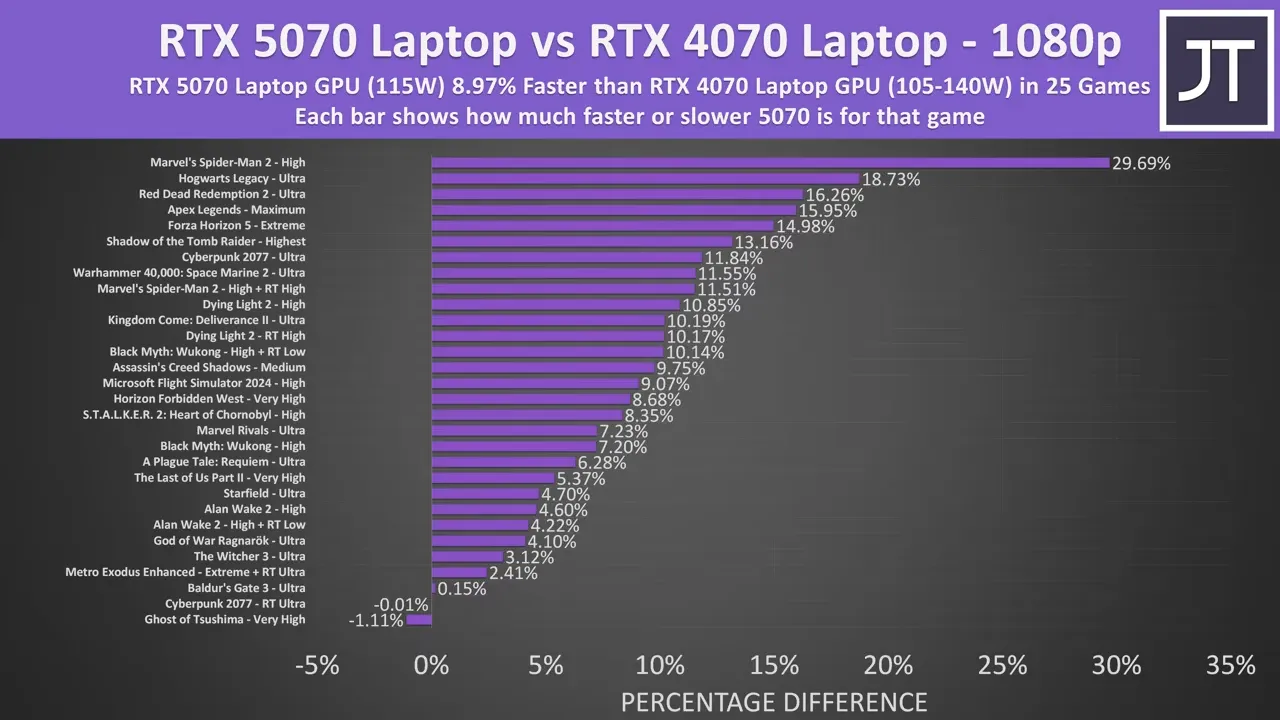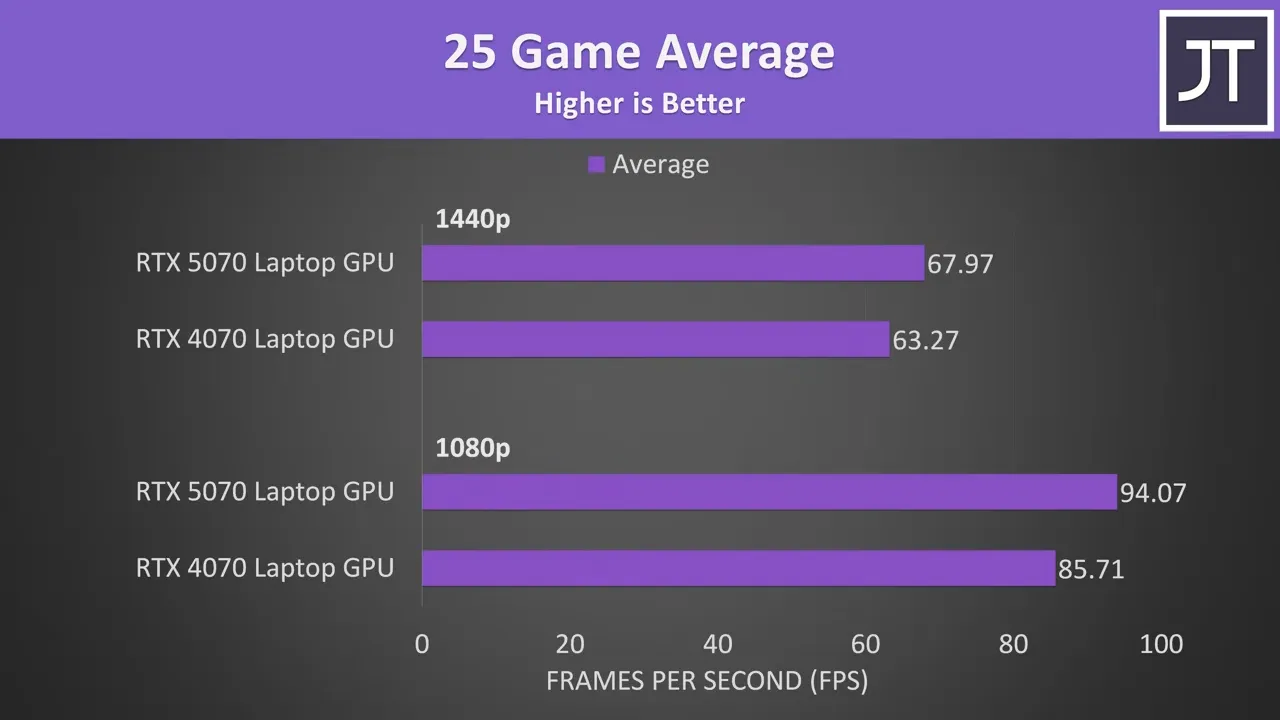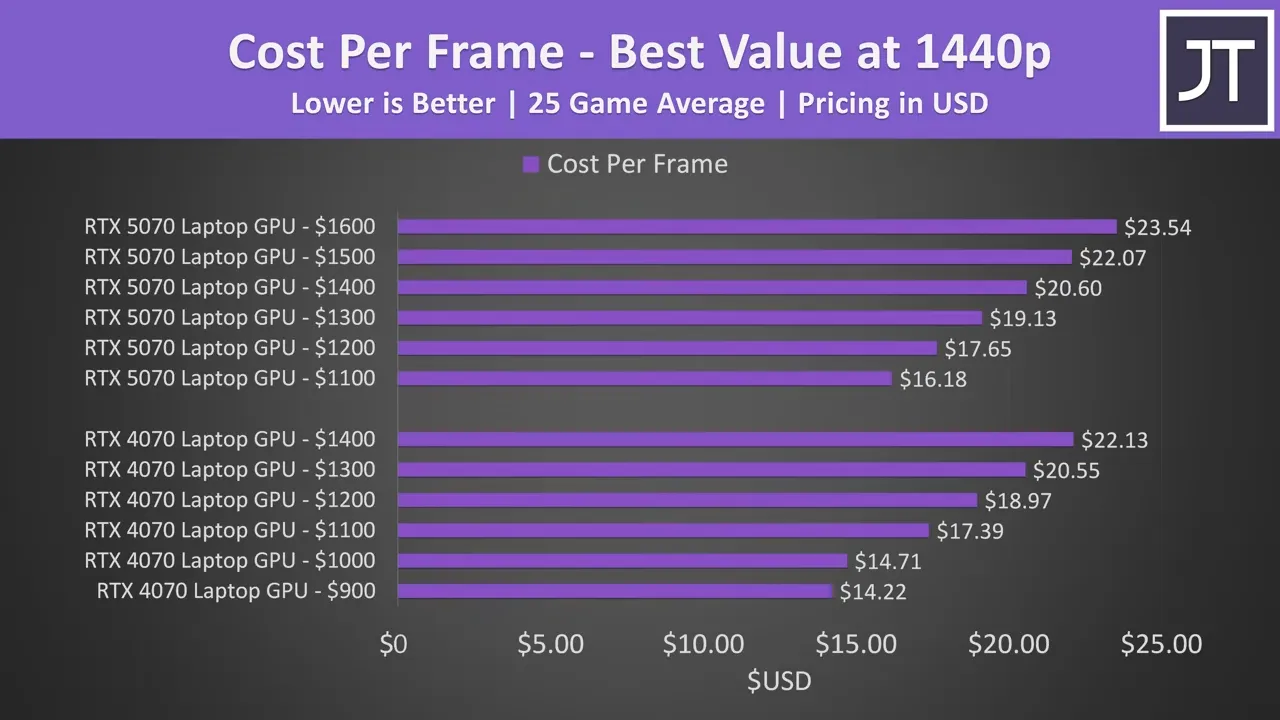NVIDIA’s latest RTX 5070 laptop GPU has arrived, but on paper, it looks strikingly similar to last generation’s RTX 4070. Both GPUs share the same core configuration and VRAM, so is the new 5070 actually worth paying more for?
We put both GPUs to the test across 25 games at 1080p and 1440p resolutions to find out where the real differences lie and help you decide which one offers the best value for your next gaming laptop.
Specs Showdown: More Alike Than Different
At a glance, the spec sheets tell a story of minimal change:
| Spec | RTX 4070 Laptop GPU | RTX 5070 Laptop GPU |
|---|---|---|
| CUDA / Tensor / RT Cores | Identical | Identical |
| VRAM | 8GB GDDR6 | 8GB GDDR7 |
| Memory Bus | 128-bit | 128-bit |
| Typical Power (Real-World) | ~100-110W | ~115W |
| Max Boost Power (Claimed) | 140W (with Dynamic Boost) | 115W |
The key differences boil down to the 5070’s newer, faster GDDR7 memory and a slightly different power reality. While the 4070 can technically boost higher, in practice, it often runs between 100-110W, much closer to the 5070’s 115W limit.
Synthetic Benchmarks: A Clear Efficiency Lead
Before diving into games, synthetic benchmarks revealed a consistent trend. In 3DMark Time Spy, the RTX 5070 outperformed the RTX 4070 by approximately 11% when both GPUs were running at the same power level, whether at 115W or a lower 50W. This points to a genuine architectural efficiency improvement in the new generation.
Even when the 4070 was allowed to run at its peak 130W, the 5070 still held a lead of just under 8%.
Real-World Gaming Performance: The 25-Game Average

Testing was conducted on two Lenovo Legion 7i laptops. It’s important to note that the 5070 model also featured a newer CPU and faster RAM, which reflects a real-world purchasing scenario but means some performance gains are not from the GPU alone.

After testing 25 games, the average FPS difference was:
- At 1080p: The RTX 5070 was ~9% faster on average.
- At 1440p: The RTX 5070 was ~7% faster on average.
The smaller lead at 1440p helps isolate the GPU’s contribution, suggesting the raw GPU performance uplift is likely in the 7-8% range, with the remainder of the 1080p gain coming from the newer CPU.
Game-by-Game Highlights
The experience varied significantly from game to game:
- Biggest Win (CPU-Bound): Spiderman 2 saw massive gains of 30% at 1080p and 21% at 1440p, likely heavily influenced by the newer CPU.
- Typical Gain: Most titles, like Black Myth Wukong and Alan Wake 2, showed a 5-10% uplift with the 5070.
- No Difference: Ghost of Tsushima performance was “basically the same” on both laptops.
- Anomalies: Red Dead Redemption 2 performed worse on the 5070 laptop at 1440p, potentially due to a driver or optimization bug with new Intel/RTX 50-series combinations.
The Multi-Frame Generation Question
A key marketing point for the RTX 50-series is “Multi-Frame Generation.” This allows the 5070 to generate more AI frames (3x or 4x mode) compared to the 4070’s standard 2x Frame Generation.
Our take: While Frame Generation is a fantastic feature for reducing stutter and boosting smoothness in less latency-sensitive, single-player games, it’s not a reason to choose the 5070 alone.
- The 4070 still has access to standard 2x Frame Generation.
- Comparing AI-generated frames to native-rendered frames is not an apples-to-apples comparison, as it can introduce latency and occasional visual artifacts.
- Multi-Frame Gen is a “nice-to-have” extra, not a must-have feature that defines the generation.
Power, Heat, and Efficiency
The newer laptop drew 3-4% more power at the wall (not just the GPU). However, because it was delivering more frames, the RTX 5070 system was more power-efficient on a performance-per-watt basis. The 5070 GPU itself also ran slightly warmer and maintained higher clock speeds, consistently hitting its 115W power target in games.
The Bottom Line: Is the RTX 5070 Worth It?
The answer, as always, comes down to price and availability.
As of early September, the market dynamic is unusual: RTX 4070 laptops are becoming scarce, and their prices are often rising. Meanwhile, RTX 5070 laptops are hitting the market at competitive prices.
- If prices are equal: The RTX 5070 is the clear winner, offering a ~7% pure GPU performance uplift, better efficiency, and access to newer features. It feels more like a “4070 Ti” than a true next-generation leap.
- If you find a deal: An RTX 4070 laptop on a significant sale remains an excellent buy. You are not missing a massive generational leap in raw performance.
Current Pricing Context (Early Sept):
- RTX 4070 Laptops: ~$900 (entry-level) to $1400 (premium)
- RTX 5070 Laptops: ~$1100 (entry-level) to $1300-$1400 (mid-range)
From a cost-per-frame perspective, a $1100 4070 laptop offers similar value to a $1200 5070 laptop. That extra $100 only gets you that ~7% more performance at 1440p.

A Final Word of Caution: 8GB VRAM
Both of these GPUs come with 8GB of VRAM. For high-end 1440p gaming, this is already becoming a limiting factor in some modern titles. Before you pull the trigger on any laptop with 8GB of VRAM, ensure you research the specific games you play to avoid frustrating stutters or the need to lower texture settings in the future.
In case you have found a mistake in the text, please send a message to the author by selecting the mistake and pressing Ctrl-Enter.
Sign In





